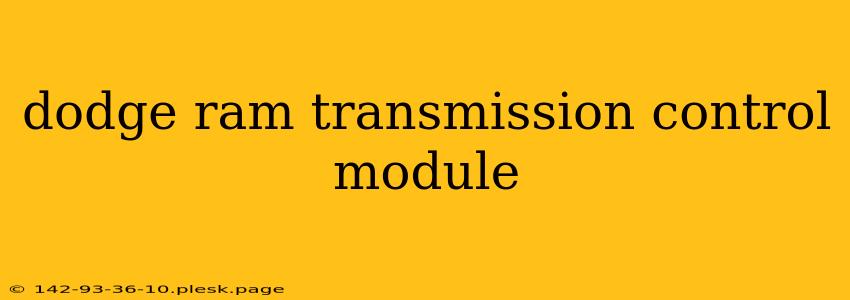The Dodge Ram transmission control module (TCM) is a critical component responsible for managing your truck's automatic transmission. When it malfunctions, you can experience a range of problems, from rough shifting to complete transmission failure. Understanding the TCM, its potential issues, and the process of troubleshooting and replacement is crucial for Dodge Ram owners. This comprehensive guide will delve into these aspects, helping you navigate common TCM-related challenges.
Understanding the Dodge Ram Transmission Control Module
The TCM acts as the "brain" of your transmission, constantly monitoring various sensors and actuators to optimize shifting performance. It receives data on vehicle speed, engine load, throttle position, and transmission fluid temperature, using this information to adjust shift points, torque converter lockup, and other transmission functions. A malfunctioning TCM can lead to significant drivability issues and potentially costly repairs.
Common Symptoms of a Failing TCM
Several symptoms can indicate a failing TCM in your Dodge Ram. These include, but are not limited to:
- Rough Shifting: Jerky shifts, harsh engagement, or slipping gears are common indicators.
- Transmission Slipping: The transmission may fail to engage properly, or gears may slip under acceleration.
- Check Engine Light (CEL): A illuminated CEL, often accompanied by specific diagnostic trouble codes (DTCs), points towards a potential TCM problem. Note: A CEL doesn't automatically mean the TCM is at fault; it's a symptom requiring further investigation.
- Limp Mode: The transmission may enter "limp mode," restricting its functionality to protect the transmission from further damage. This often limits you to a single gear.
- No Start Condition: In some cases, a severely faulty TCM can prevent the vehicle from starting altogether. This is less common but possible.
- Inconsistent Performance: Erratic shifting behavior that changes depending on conditions (temperature, load etc.) suggests potential electrical issues that could point to the TCM.
Troubleshooting Your Dodge Ram TCM
Before replacing the TCM, systematic troubleshooting is essential. This can save you time and money:
1. Diagnostic Trouble Codes (DTCs):
The first step is to retrieve any DTCs stored in the vehicle's computer. A professional-grade scan tool is needed to access these codes. The codes will provide valuable clues about the nature of the problem. Many auto parts stores offer free DTC scans.
2. Inspecting Wiring and Connectors:
Carefully examine the wiring harness and connectors associated with the TCM. Look for any signs of damage, corrosion, or loose connections. Repairing any damaged wiring is crucial before considering TCM replacement.
3. Transmission Fluid Check:
Low transmission fluid level or contaminated fluid can mimic TCM symptoms. Check the fluid level and condition; if needed, have the fluid and filter changed.
4. Testing Other Components:
Certain sensors and actuators connected to the TCM can cause similar issues. Thorough testing may reveal a faulty sensor rather than a failing TCM. This often requires specialized diagnostic tools and expertise.
Replacing the Dodge Ram TCM
Replacing the TCM is generally best left to a qualified mechanic, especially if you are not comfortable working on vehicle electronics. The process involves:
- Disconnecting the battery: This is crucial to avoid electrical damage.
- Locating the TCM: The TCM's location varies depending on the year and model of your Dodge Ram. Consult your vehicle's repair manual for the precise location.
- Disconnecting the connectors: Carefully disconnect all wiring harnesses from the TCM.
- Removing the TCM: This may involve removing other components for better access.
- Installing the new TCM: Install the new TCM, ensuring all connections are secure.
- Programming the TCM (Often Necessary): Many newer TCMs require programming to match your vehicle's specific configuration. This requires specialized tools and software.
- Reconnecting the battery: Carefully reconnect the battery after installation.
Conclusion
A malfunctioning Dodge Ram transmission control module can lead to significant drivability issues. Through careful diagnosis and possibly professional intervention, the problem can often be resolved effectively. Remember, accurate troubleshooting is key to identifying the root cause and avoiding unnecessary repairs. Always consult your vehicle's repair manual or seek professional help when facing complex transmission problems.

